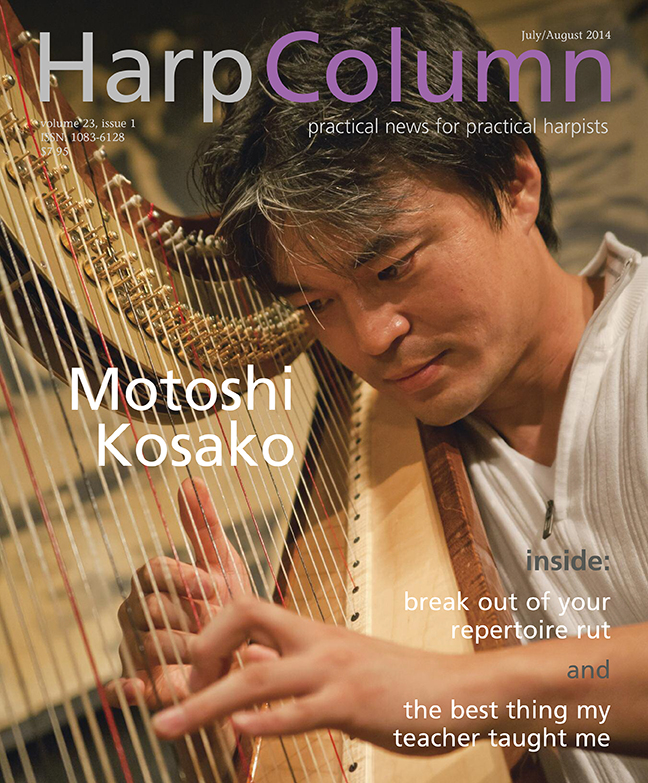Deciding whether a used harp is the right choice.
Y’all know Peter Wiley, right? Harp technician extraordinaire, oracle of knowledge and wisdom, the “Harp Doc.” He once said to me, “Mike, a harp is three things: a musical instrument, a mechanical device, and a work of art.”
Keeping this observation in mind, let’s take a look at a common question I am asked as a harp technician: “How much is this used harp worth?” There are endless variations of this question: How much can I get out of my old harp? How much should I pay for this used harp I found on eBay? What is the fair market value of the harp in grandma’s attic?
[protection_text]
Expert Opinion
When you ask your trusty harp technician to tell you whether to pull the trigger on a used harp, first consider what a harp technician is and, more importantly, is not.
Evaluation of the mechanical components of your harp is where your technician shines. Just as your doctor can tell you about your general physical health, show you risk factors, and guess at longevity, a harp technician can do the same for your harp or the harp you are about to buy.
Can your technician make a call on your harp as a musical instrument or a work of art? Well, sure, we can, but personally, I like to stay away from these aesthetic judgments. “Isn’t my harp beautiful?” “Don’t you just love the sound?” “Yes doctor, but do you think I’m handsome?”
If you want to see the nuts and bolts (pardon the pun) of how to do this mechanical evaluation for yourself, you can watch my video at harpcolumn.com. But right now, let’s consider some hypothetical scenarios to illustrate the important criteria.
Harps and Harpists
Below are three would-be harp buyers. We are going to pit them against three used harps that are for sale and play red light, yellow light, green light.
Meet our harpists:
• Young student, advanced for her age, needs at least a semi-grand to continue progressing.
• Adult beginner with financial resources.
• Professional player looking for casual gig harp or decent second harp.
Meet the harps:
• Old gold, major issues, extremely high mileage but playable.
• Non-gold with some mileage.
• Instrument with all its original parts, normal nicks and blemishes, very low mileage.
What’s mileage?
A high-mileage harp has been around the block and seen it all. The harp has clicks and clacks in the action, a few cracks here and there, gold that’s been painted over. Knee marks on the body, make-up stains on upper left side of the body, fingernail marks in the soundboard, dents, nicks, and scratches, but is still playable. Intonation? It is really sharp when the pedals are down. Buzzes? Yes, but tolerable.
[pullquote]Most harpists agree that a broken-in harp sounds better than a new harp. Based on that, my question for the harp market is: “Why are used harps cheaper than new harps?”[/pullquote]
A harp with some mileage has seen its fair share of active duty, but has been refurbished with a new neck and action parts. This classification could also include a newer-model harp that has been restored. Either way the harp may have some nicks and scratches or very minor clicks and clacks, but no structural cracks.
A low-mileage harp has all of its original factory parts, as in the parts God gave your harp when it was born. Absolutely nothing after-market. It’s essentially a new used harp, even if it is 40 years old. The harp has very few clicks and clacks in the action, maybe a scratch or two in the finish. The soundboard may or may not be broken in.
The Matrix
 Check out the matrix (right) for our harpists considering the used harps we talked about. Any surprises? Any exceptions you can think of? I can think of a few but I’ll leave it to you to decide.
Check out the matrix (right) for our harpists considering the used harps we talked about. Any surprises? Any exceptions you can think of? I can think of a few but I’ll leave it to you to decide.
Red light: Stop. Don’t do it. You’ll likely have a major case of buyer’s remorse.
Yellow light: Proceed with caution. This harp may or may not be a good buy. You need to carefully weigh the pros and cons with your teacher or harp bestie.
Green light: Go for it. As harp purchases go, this is likely a safe bet.
Risky Business
 There is still the question of financial risk to consider. While this is far from exact, you can at least get an idea of how much money you would be putting on the line with a used harp purchase and compare that to your personal comfort level with financial risk by plugging in your numbers to the equations at right (click on the photo to enlarge).
There is still the question of financial risk to consider. While this is far from exact, you can at least get an idea of how much money you would be putting on the line with a used harp purchase and compare that to your personal comfort level with financial risk by plugging in your numbers to the equations at right (click on the photo to enlarge).
Buy or Bye-bye
Most harpists agree that a broken-in harp sounds better than a new harp. Based on that, my question for the harp market is: “Why are used harps cheaper than new harps?” My two cents is that it is because everyone talks sound but walks furniture. Do looks trump sound every time? I hope this article can help launch productive discussions with your harp teacher and technician. Their practical and objective insight into your situation is invaluable. •
San Francisco-based harp technician Mike Lewis started working at a harp factory in Chicago in 1989. In 1996 he started his own business, HarpTech. Contact him with suggestions of topics you’d like to see in Tech Talk at harptech@harptech.com.






